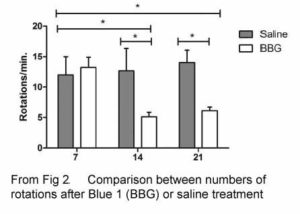F errazoli, de Souza, Nascimento, Oliveira-Giacomelli, Schwindt, Britto, Ulrich. Cell Transplantation. 26: 669-677.
errazoli, de Souza, Nascimento, Oliveira-Giacomelli, Schwindt, Britto, Ulrich. Cell Transplantation. 26: 669-677.
This paper describes an effect of Blue 1 of
potential medical benefit in Parkinson’s
disease. Basically, it can be used to suppress a receptor that is over-active and causing damage in people with Parkinson’s.
Purinergic signaling activates ATP and influences various functions including neurotransmission. However, with too much release of ATP and sustained P2X7 receptor activation, cell death is induced, resulting in Parkinson’s disease. Thus, the P2X7 receptor is one “target” for drugs to suppress it. Another target is a protein called PGC-1α, involved in energy metabolism.
Using a rat model of Parkinson’s disease, the P2X7R antagonist Brilliant Blue G (a Blue 1 analog) was shown to be helpful.
NOTE: While this may be medically useful, should people without Parkinson’s disease, who don’t have an overactive P2X7 receptor, be eating this medication in their breakfast cereal and fun drinks?




















